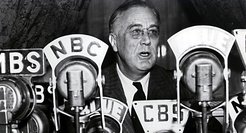Communicating Feelings

The Attitudes of Parliament: How Architecture Regulates Political Emotions in Germany
Philipp Nielsen
With the rise of participatory politics in the nineteenth century, parliaments were established across Europe and the US. The history of German parliamentary buildings, such as the Reichstag in Berlin and the Bundeshaus in Bonn, shows that emotions were not only felt within their walls, but were built into their very architecture.
Emotions were visibly manifested in architectural forms that embodied specific political ideas. Within the assembly halls, parliamentarians needed to create their own rules of behaviour, all of which had a spatial dimension: how to sit, where to sit, when to speak, when not to speak, and how to deal with those not following these rules, for instance by expelling them from the chambers. In their relationality to the bodies of parliamentarians, these spaces and rules reflected assumptions about emotions, democratic or otherwise. Political spaces and emotions intersected and produced each other, though not always in the ways that politicians or architects intended.
The Attitude of a Nation: How US President Franklin D. Roosevelt Built a New Relationship with the Federal Government through His "Fireside Chats"
Michael Amico
The rise of new technologies, first with the newspaper and then the radio, expanded the audience of political speech beyond the walls of parliament and the physical proximity of the speaker. This chapter focuses on how, in the middle of the Great Depression, US President Franklin D. Roosevelt made Americans feel a new sense of confidence and trust in the federal government through his ‘Fireside Chats’, a series of thirty-one radio speeches heard by a majority of Americans between 1933 and 1945. The particular style and means of Roosevelt’s emotional templates were informed by his personality as a politician, his philosophy of democracy, and the medium of radio itself.
His radio ‘chats’ turned institutional tasks and obligations into high drama that, in a world of competing political rhetoric and division, put the power of change in every American’s hands. Even those who were not directly helped by Roosevelt’s ‘New Deal’ legislation and social programs wrote to him to say how his words and images had templated their anxiety, grievance, and fury into courage and hope. They would do all they could to help him and the country, a commitment that served to boost morale and further unite the country during the Second World War.
The Attitudes of Presidents: How Pictures Portray Leadership
Kerstin Maria Pahl
Portraits of politicians address the population, direct political opinion, promote types of leaders, convey moral values, and bolster narratives. represent a combination of politics in pictures with a politics of the visual: emotions shape the construction of political images, while images also shape the production of political emotions. Analysing the portraits of three American presidents, George Washington, Franklin D. Roosevelt, and Barack Obama reveals their nuanced strategies of navigating a wide repertoire of emotions, thereby impacting political discourse.
Portraits, however, not only depict emotional styles but also spur emotions in fostering support or, conversely, disaffection. They signify shifts in the preferences of particular types of politicians, while the practices of looking, hanging, collecting, and imitating often entail emotionally charged responses to a portrait.
